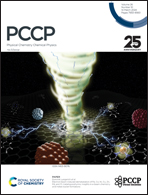How space-charge behaviour at grain boundaries in electroceramic oxides is modified by two restricted equilibria†
Abstract
Determining the space-charge potential at grain boundaries in oxides by various experimental methods bears the promise of providing a comprehensive, quantitative description of interfacial defect chemistry. In this study, we draw attention to the problem of unifying data measured in different temperature ranges. We focus on unifying data from elevated-temperature electrical methods, such as impedance spectroscopy and current–voltage measurements, with data from room-temperature imaging techniques, such as Scanning Probe Microscopy (SPM), Transmission Electron Microscopy (TEM), and Atom Probe Tomography (APT). By means of continuum simulations, we calculate the space-charge potential Φ0 at grain boundaries in the model electroceramic oxide acceptor-doped SrTiO3, taking into account, first, a restricted equilibrium that leads to frozen-in acceptor-dopant profiles, and subsequently, a restricted equilibrium that leads to frozen-in bulk oxygen-vacancy concentrations. Our results indicate non-trivial differences between experimental values of Φ0 obtained from electrical and from imaging methods, differences that arise from the different measurement temperatures and that are aggravated by the restricted equilibria. We also show that grain-boundary widths determined from elemental acceptor-cation profiles will not, on principle, agree with the electrical width extracted from impedance spectroscopy data.



 Please wait while we load your content...
Please wait while we load your content...